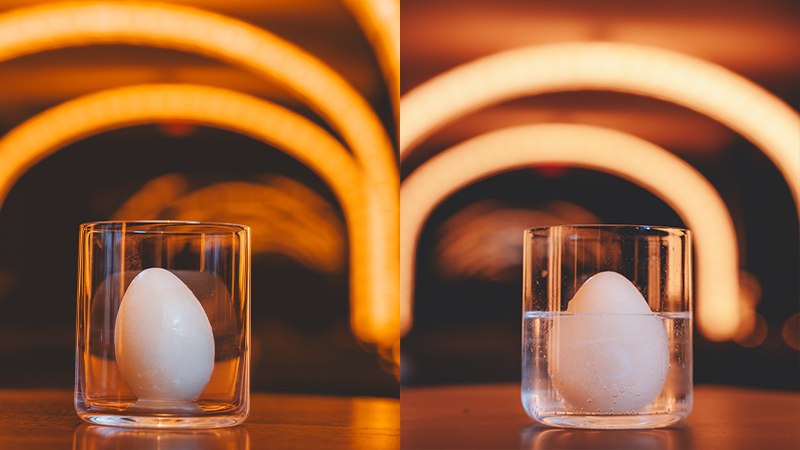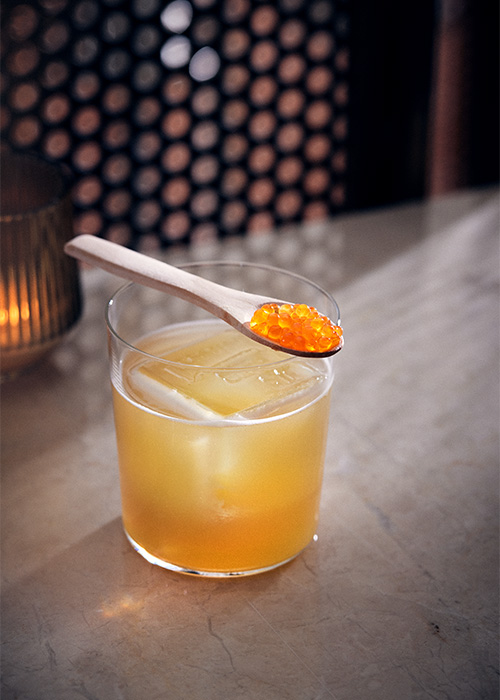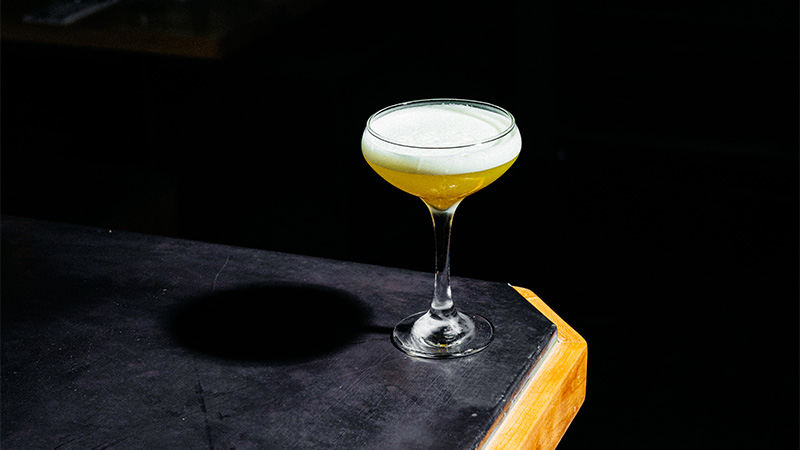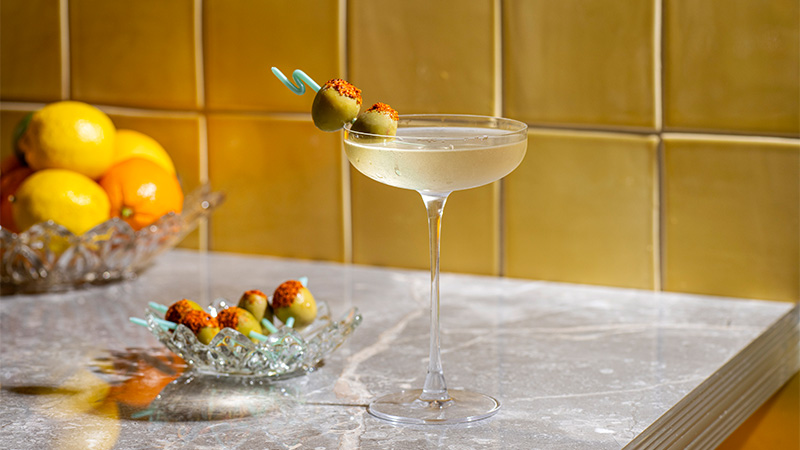Over the past few years, New York City’s cocktail scene has become a bit… extra. On any given night, drinkers can sip a Martini while doing a caviar bump off of a mannequin hand at Martiny’s; drink an Orange Julius-inspired cocktail from a hollowed-out, flash-frozen orange at Shinji’s; have a Vegemite-infused beverage behind at doughnut shop at Ra Ra Rhino; or even indulge in a provocative Cigarette Martini in Tigre’s gold-accented ‘70s-themed lounge. Don’t bother searching — there’s no clear unifying theme to these over-the-top drinks, except for the fact that they’re all embracing NYC’s chaotic new tilt toward maximalist experiences.
New York’s post-pandemic bar landscape was quick to make up for lost time, with a rapid rise of avant-garde presentations, offbeat flavor combinations, and luxurious garnishes. Now, the trend is seeping into restaurant culture and even playing out on cocktail menus on the fine-dining stage. Even at Tatiana — a spot The New York Times has dubbed the No. 1 restaurant in NYC for two years running — guests can dine under floating clouds that radiate blue light while eating a cosmic brownie and slinging back artisanal Jell-O shots.
High-end restaurants historically feature impressive cocktail lists, but now ever more spots complement their creative dishes with equally compelling drinks that flaunt unexpected ingredients and presentations. In this maximalist era — and in New York in particular — where tableside service and heaps of caviar feel commonplace, how can beverage programs stand out without crossing the line into gimmicky territory?
Considering the Camera
In an era that boasts cold pizza-inspired cocktails, Espresso Martinis topped with cotton candy flowers, and extremely liberal use of the flavor blaster smoke bubble gun, it’s natural to ponder: How exactly did we get here?
Jack Schramm, Brooklyn-based bartender and founder of Solid Wiggles (the company behind Tatiana’s signature Jell-O shots), suggests that our craving for frivolous dining experiences can be traced back to the pandemic lockdown.
“We were so starved for so long of that sense of fun,” he says. “Now if we spend the time and money to go out, it better be ridiculous and we better be able to show people on the internet.” As Schramm suggests, social media has played a significant role in the rise of theatrical dining, and is an essential part of what gets customers in the door in the current restaurant landscape. “Having something that drives social media engagement is an unfortunate reality of the restaurant business these days,” he adds.
One restaurant that clearly capitalized on the power of social media is Coqodaq, the self-proclaimed “fried chicken cathedral” from the team behind Michelin-starred Cote. When the restaurant opened earlier this year, The Egg cocktail incited almost as much of a social media frenzy as the restaurant’s already iconic caviar-topped Golden Nuggets. The inventive drink features prominently in the center of Coqodaq’s “coqtail” menu, and has stirred so much hype on Instagram that diners might forget that the beverage program also features the largest selection of Champagne in the U.S.
“The challenge is to find that social media moment while keeping it simple and visually clean.”

For Sondre Kasin, the principal bartender for Coqodaq, Cote, and Undercote, it was a priority to design a lineup that pairs well with the hot spot’s signature Korean fried chicken. But he also contemplated the drinks’ aesthetics, wanting to design a central cocktail that would make an impression without being gaudy.
“The challenge is to find that social media moment while keeping it simple and visually clean,” he says. “You’re going to make the drink so many times a day, you don’t want it to look gimmicky.”
The Egg, which Kasin considers a riff on the classic Vodka Soda, doesn’t tout any flashy colors or flames, but instead just a singular white, egg-shaped ice cube in the middle of the glass that then receives a carbonated mixture of Grey Goose Vodka and St. Germain. The egg itself isn’t just a superficial stunt, it’s designed — using techniques from gelato making — to add jasmine flavor to the drink over time.
“When it dissolves it creates a foam layer on top of the drink,” Kasin adds. “The cocktail tastes like a typical Vodka Soda for one minute, and as you keep going you get more flavor, and at the end it has a sweet and sour profile.”
Tasteful Luxury
One theme that’s irrefutably played out in the maximalist dining sphere is the abundant use of caviar. From tossing the precious roe on mozzarella sticks to drinks adorned with caviar-stuffed oysters, these luxury moments are a dime a dozen in NYC’s chaotic phase. While anyone can pile a heap of caviar onto something, the most impressive menus in this new era evoke a feeling of splendor while remaining authentic.
At Bangkok Supper Club, a new restaurant from the team behind the popular Thai restaurant Fish Cheeks, the food is designed to transport diners to the late-night food scene of Thailand — and the drinks follow suit.

Beverage director Suwincha “Chacha” Singsuwan was still living in Bangkok when she started developing the restaurant’s beverage program, and the influence is apparent. The cocktails are served on large blocks of clear ice — which, in addition to being striking, actually serve a purpose in Thailand, where it’s so hot that small ice cubes melt too quickly — and incorporate ingredients common to the city.
Bangkok Supper Club’s popular Guava Nam Jim cocktail replicates the flavors of a Thai seafood sauce, featuring chili, coriander root, and a garnish of trout roe. And while Singsuwan insists that the delicately placed spoon of orange roe that lies on top of the drink isn’t a nod to the of-the-moment caviar bump, there’s a betting chance that’s why it’s the restaurant’s most ordered drink.
Stand-Out Savory Ingredients
Surprising savory ingredients also draw the guest’s attention in this new era. While some spots boast hot dog- or pickle-inspired drinks for pure shock value, others draw a clear connection to the cuisine.
When the MSG Martini debuted at the Cantonese-American restaurant Bonnie’s, the radical preparation shocked drinkers and critics alike. Others scrambled to replicate the approach, but few have received as much praise. Emerging from this trend are some cocktails that will truly make you do a double take at the menu, but seamlessly fit into the restaurant’s overall theme.
At Corima, a new northern Mexican restaurant with Japanese influence, the Uni Gin Sour turns heads. The idea first took form in the kitchen when there was some leftover uni available. The resulting concoction adds the bright yellow delicacy to gin, lemon juice, simple syrup, and egg white to make a foamy, shaken drink.

“It seemed like a no-brainer to bring onto our menu as we are really embracing Japanese ingredients and techniques in our food,” Vince Ott, Corima’s general manager, says. “It’s also not this fishy, brine bomb like you might expect. The flavors are much more nuanced and it adds a really nice grounding salinity to something that has a decent sweetness and acidity.”
“It wasn’t necessarily for the wow factor. I was even worried it seemed a bit kitschy or gimmicky, but it’s honestly delicious and has been our hit cocktail.”
At Don Angie’s new seafood spinoff San Sabino, cocktails play a more central role than at the original high-end red sauce joint. Chef Angie Rito applied the same culinary approach that she used to form the restaurant’s creative Italian-American menu to the beverage program.
“We added a lot of savory elements to the cocktail program to keep it in line with the ethos of the food,” Rito says. “The restaurant is our take on Italian-American food, so we use hints and references to Italian-American culture in the drinks, but with our own twist on it.” The Scottie’s Martini, made with garlic bread vodka — the product of fat-washing the spirit with toasted garlic, olive oil, butter, herbs, and scraps of sourdough bread — along with spicy brine, lemon, and giant olives, represents one of San Sabino’s most ordered cocktails.

While the drink made a splash on social media as the “Garlic Bread Martini,” the cocktail showcases just as much culinary skill as chef Rito’s succulent shrimp parm. “It is whimsical to use garlic bread in the drink, but it does have a serious element to it,” she says.
Finding Balance
New York’s venture into outrageous dining has pushed some establishments to the extreme. But within the maximalist era, restaurants looking to innovate sometimes work in fear of their creativity coming off as meaningless or shallow.
On Corima’s buzzy Uni Gin Sour, Ott notes: “It wasn’t necessarily for the wow factor. I was even worried it seemed a bit kitschy or gimmicky, but it’s honestly delicious and has been our hit cocktail.”
As the social media craze starts to take more of a hold over our dining habits, bars and restaurants must acknowledge that viral posts inform where diners choose to eat and drink. But as some spots choose to innovate while others coast on trends, consumers need to suss out the influencer bait from the truly thoughtful, authentic creations.
“From our end it’s never been the goal to produce a social media-specific cocktail,” Coqodaq’s Kasin says. “The goal has been more to figure out a serve that’s exciting that still has a function to it.”
Still, Kasin believes that the approachable, camera-ready drinks can help grow a good rapport with the guests. “Obviously in the beginning people go for what they see on social media,” he says. “That’s part of building a trust and a relationship with the guest to start sharing things that they might also enjoy.”
